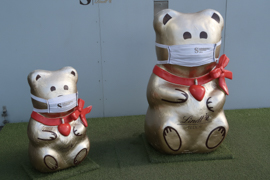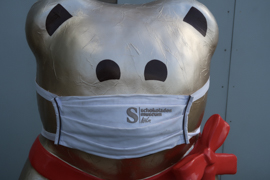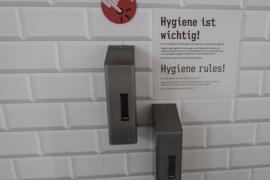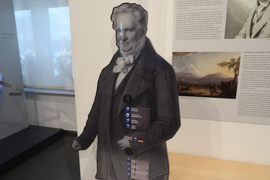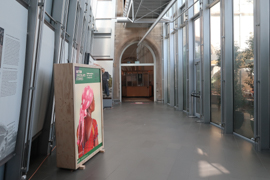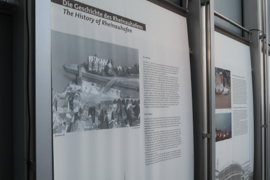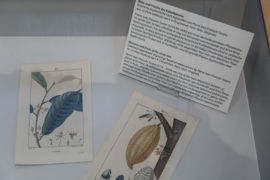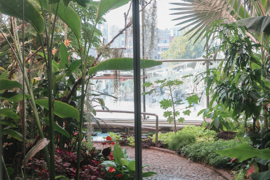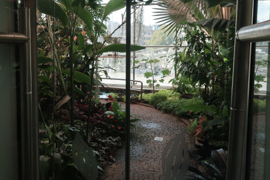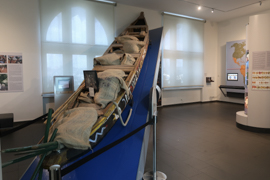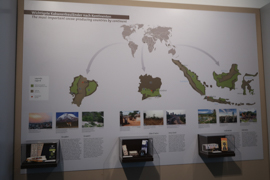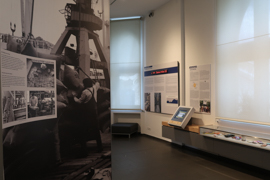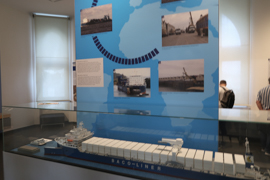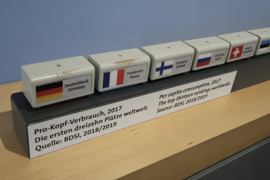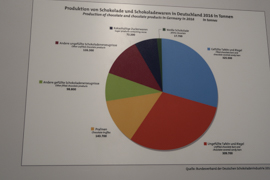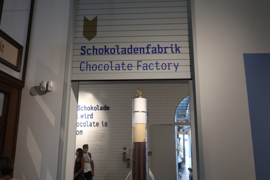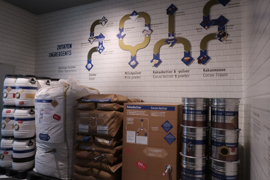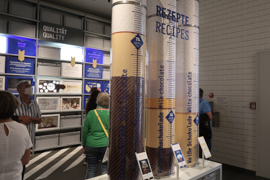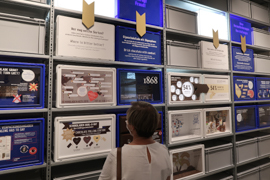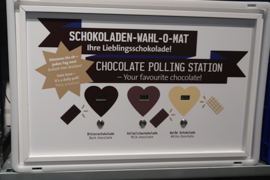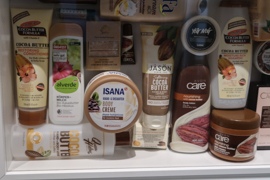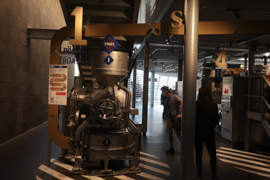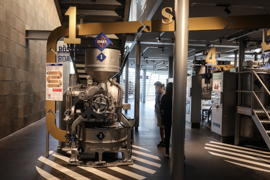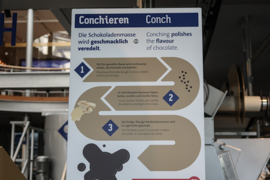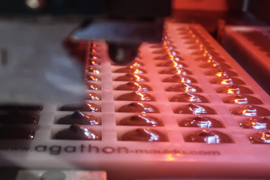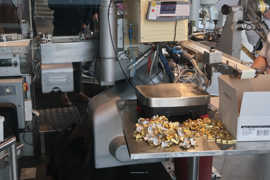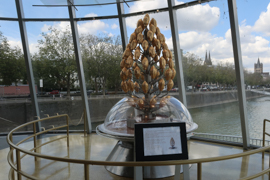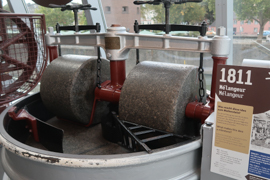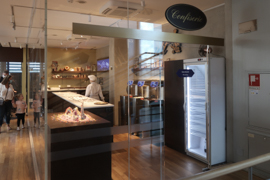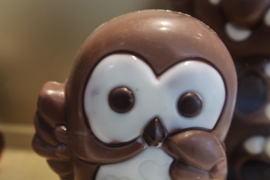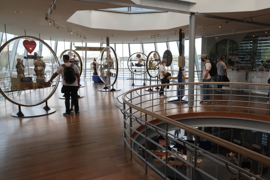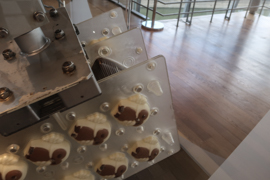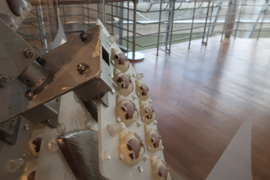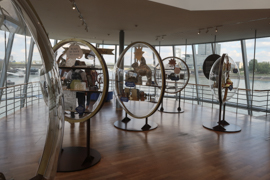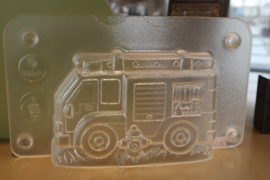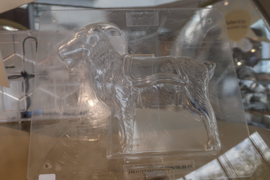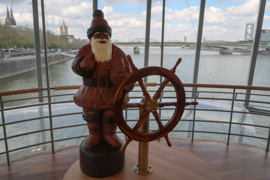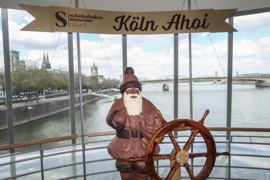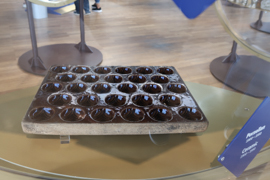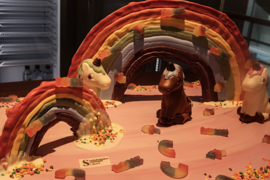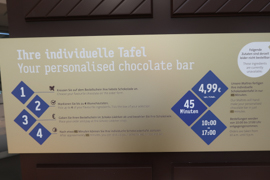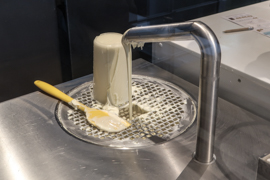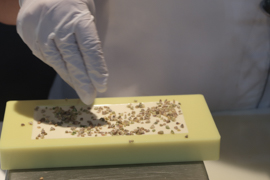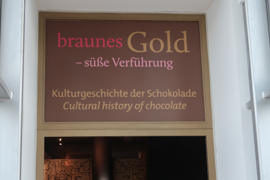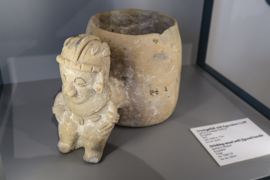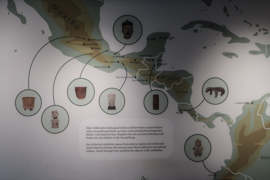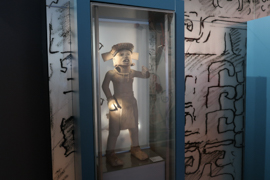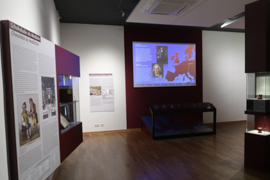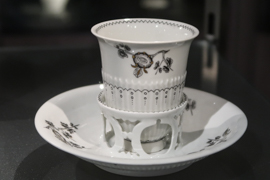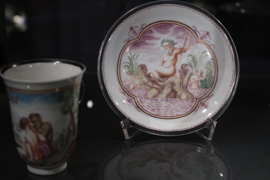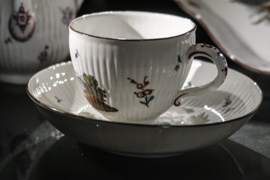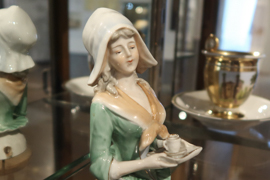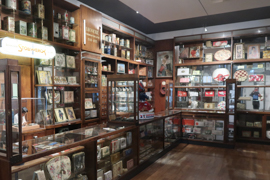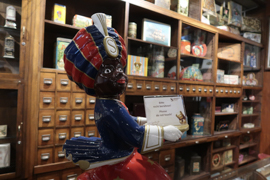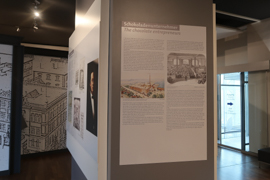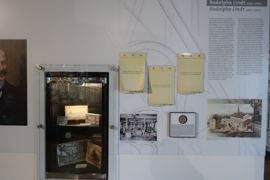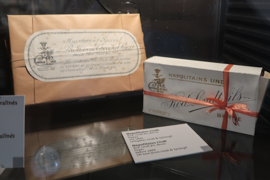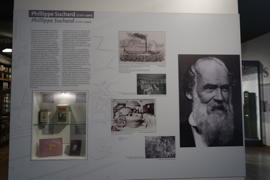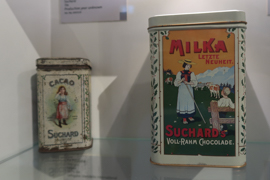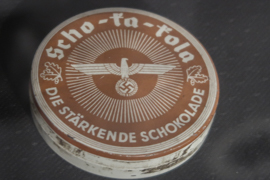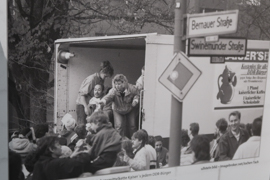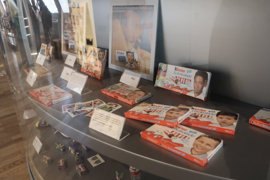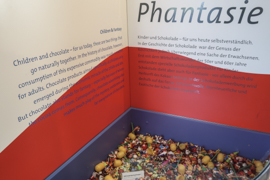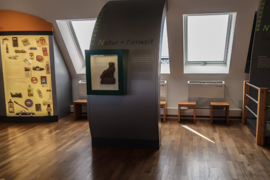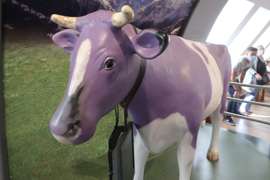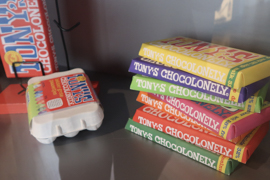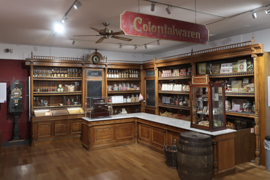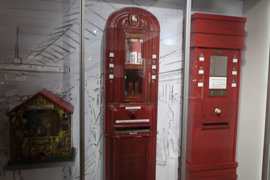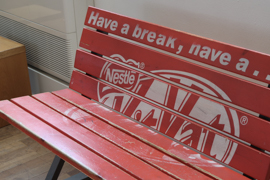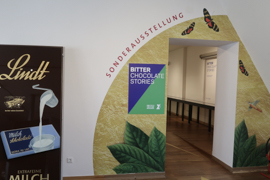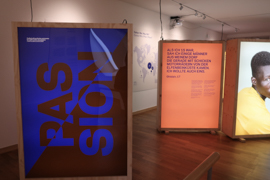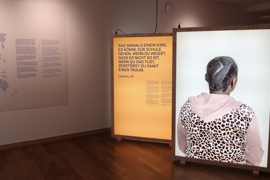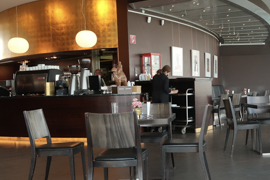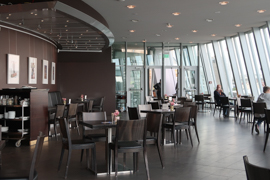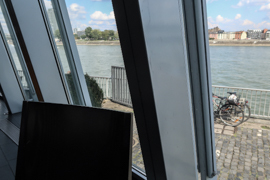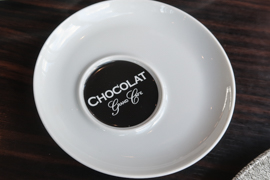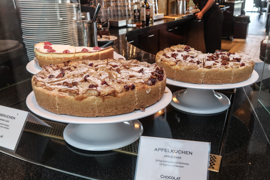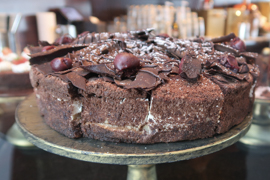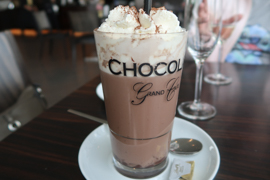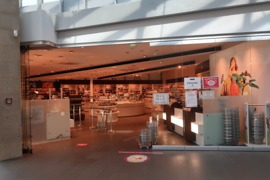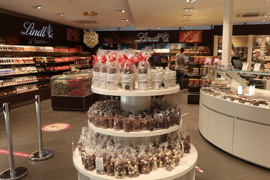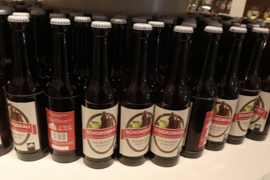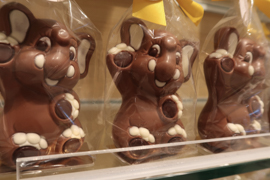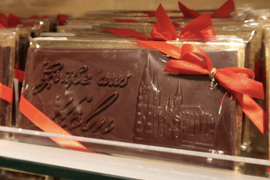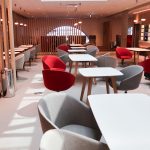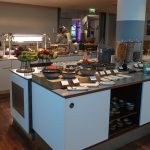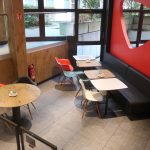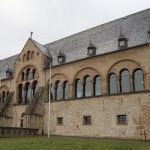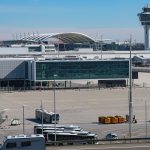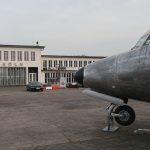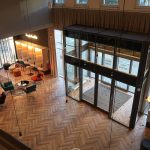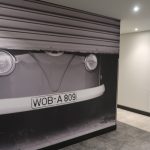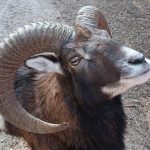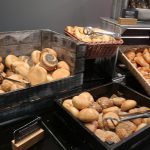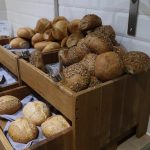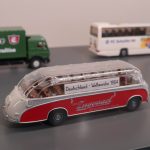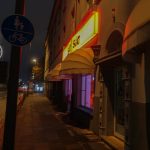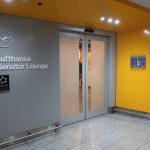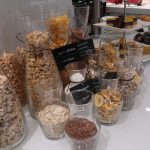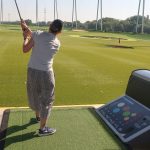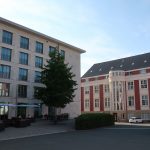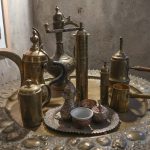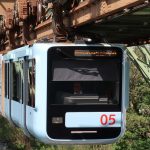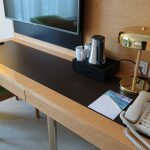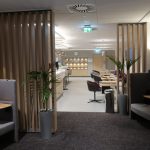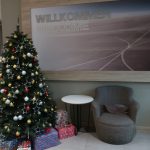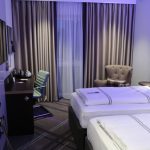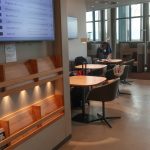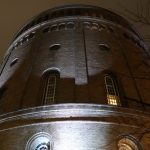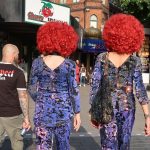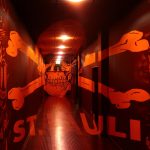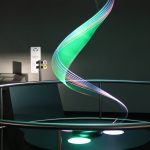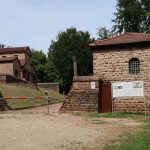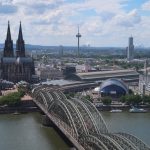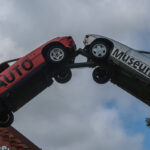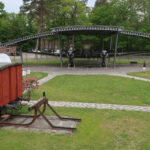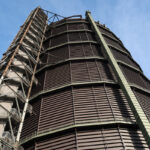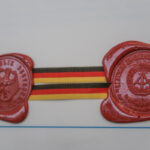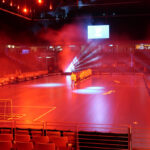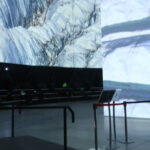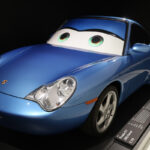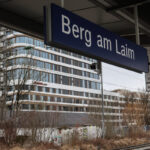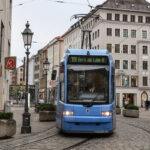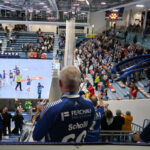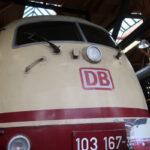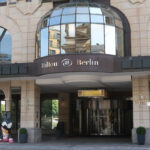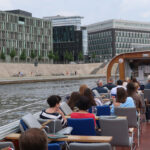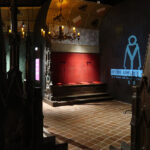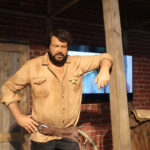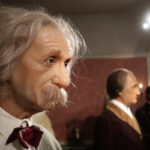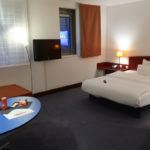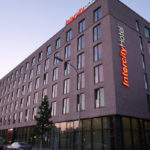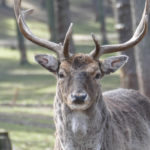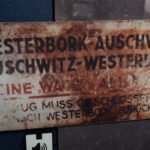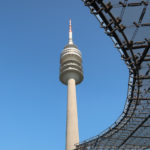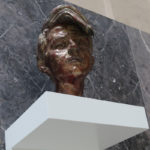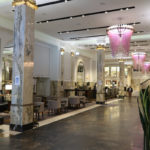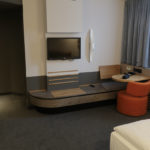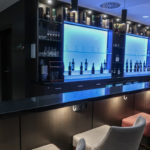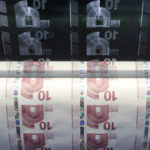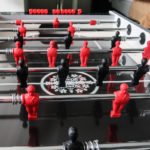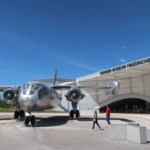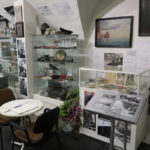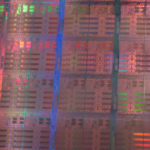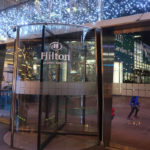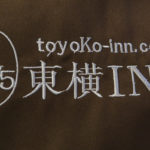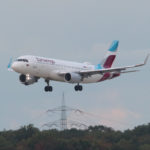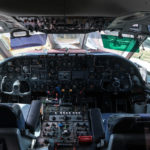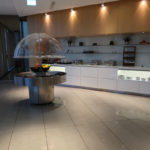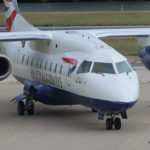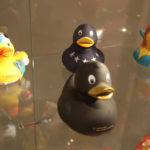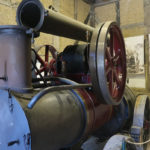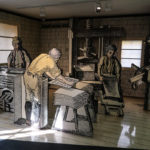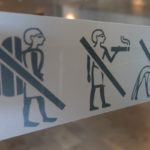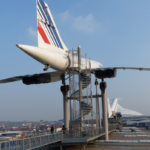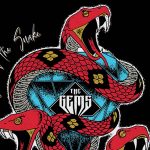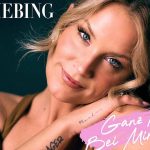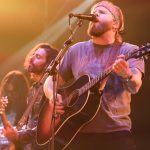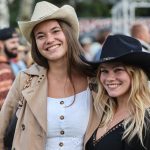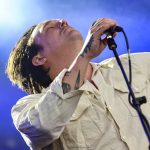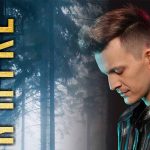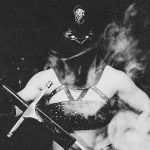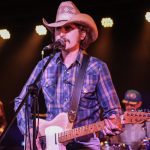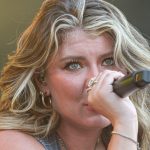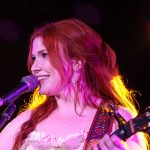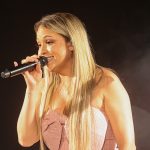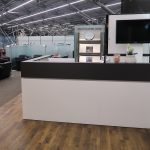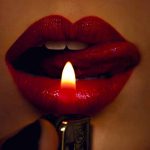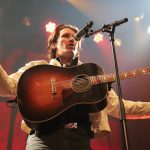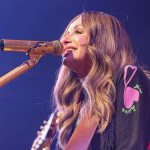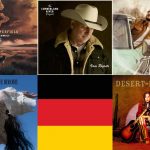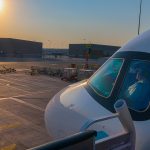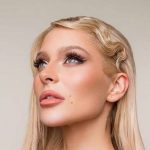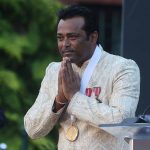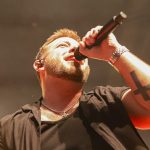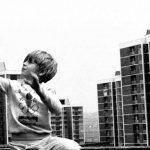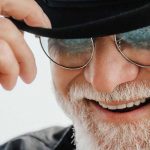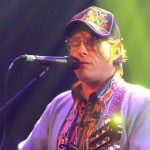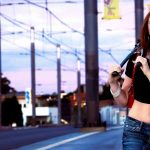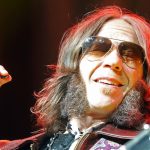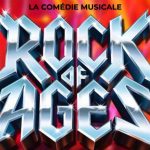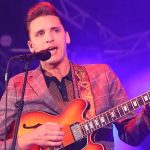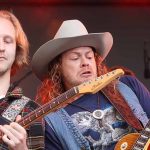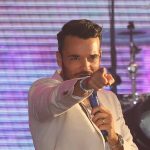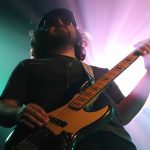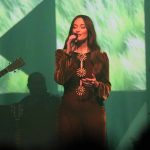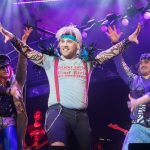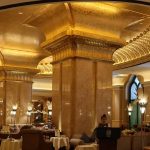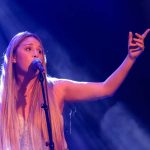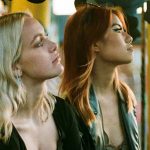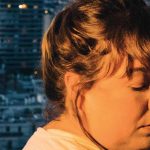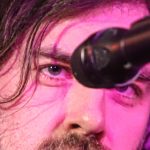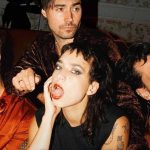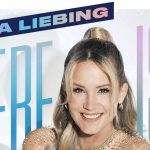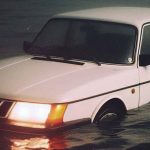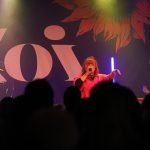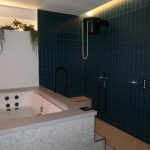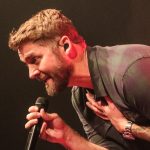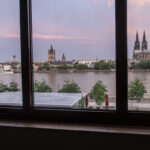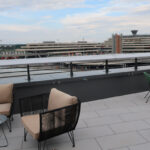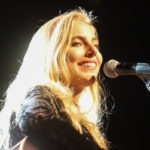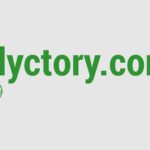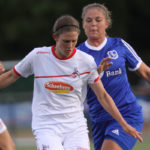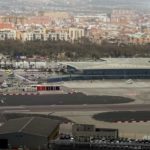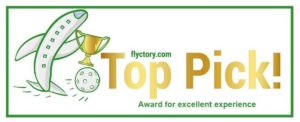Schokoladenmuseum Köln
12.50 / 13.50 EUR (adult, weekday / weekend)
Flyctory.com Pros
- Superb exhibition about cocoa growing and processing
- Very interesting exhibition about chocolate culture history
- Lovely cafe and design-your-own chocolate bar (for a fee)
Cologne Cathedral is the key attraction of my home town Cologne, of course (it is even one of Germany’s very top attractions) – but many people visiting the city stroll along the river Rhine southbound for a very different experience: The Cologne Chocolate Museum (Schokoladenmuseum Köln), nowadays driven my the Lindt/Sprüngli Swiss chocolate company, but has originally been founded by Hans Imhoff of the Stollwerck company and opened its doors in 1993. Here are my thoughts about this place.






Cologne Chocolate Museum – Location & Admission
The Cologne Chocolate Museum is located in the Rheinauhafen of Cologne, a peninsula at the River Rhine. The location is South of the very heart of Cologne and its old town, but features a lot of attractions like the German Sports and Olympic Museum or the Historic Mustard Mill. The Rheinauhafen features a huge parking garage when you arrive by car. For local transport, the Heumarkt station features tram and bus connections. There is also a bus stop right in front of the museum.
The Cologne Chocolate Museum is opening its doors more or less daily – there are a few holiday and some Monday closures in certain periods. The museum is open from 10:00 to 18:00. The adult admission Monday to Friday is 12.50 EUR, weekend pricing is one Euro higher. There are also family tickets for 31.50 / 34.00 EUR. During our visit, there was the Europa Rad ferris wheel right in front of the museum, which lead to a combined adult ticket price of 17.50 Euro.


Cologne Chocolate Museum – The Visit
The museum is taking you on a round trip, which is well signposted and organized. On the very final part of the tour only, there are some parts where you can cross each other’s path (temporary / special exhibitions). More or less the whole museum is bilingual, German and English, even the animated and interactive exhibits. Guides are available in other popular languages as well.




Basics: The Museum & Chocolate Trade
Your visit of the museum starts with some basic background about it, including a statue and some bio of Hans Imhoff. During “normal” visiting days, you would like head to the tropical greenhouse thereafter. The Cologne Chocolate Museum hosts a small tropical forest exhibition, which illustrates how cocoa is planted, growing and harvested. The place is not overwhelmingly large and due to Covid-19 regulations, this section was closed. You. however, learn about the cocoa plant as such, the chocolate-exporting countries and the conditions on the plantations (including a minor reference to children labor).








The next section is about cocoa trade, from the local markets to the shipping routes and also the per capita consumption in major countries. This section is particularly interesting, as it illustrates the importance and economic potential of cocoa.






Chocolate Manufacturing & Create Your Own Chocolate
To most of the visitors, the chocolate factory might be the key exhibit (maybe in parallel to the greenhouse). Before you enter the working production site, the first room of the factory tells you about the ingredients and also how they contribute to the final price of a bar of chocolate. You also learn how many different products, e.g. cosmetics, use cocoa as well, so that it is not only a product for nutrition.








The chocolate factory is of course a bit of down-scaled compared to an industrial side, but it is working as an in fact production side. The factory side is well signposted and structured, so that you can easily follow the route of the ingredients, which transform more and more into small chocolate bars. There is typically a robot which is handing you over freshly produced chocolate as well as a chocolate fountain, so that you can have quite some calories during your visit – again, Covid-19 required adjusted rules during our visit. The view from the chocolate fountain is by the way a Cologne classic.










If you are bored of chocolate bars, you will likely enjoy the chocolaterie one level upstairs more. It is the next part of your journey. There is an exhibition part, for example molds for chocolate figures (as well as demonstrations how they are used) and people making pralines. On the other hand, it is an opportunity to spent some funds of fresh made chocolate figures and sweet treats as well. The Santa Clause figure with a view of Cologne is another classic.
















To me, the highlight of this section is indeed the chocolate made to order. For some five Euro, you choose one kind of basic chocolate and toppings. The chocolate is produced by the staff and once it is cooled down brought to the entrance area. Processing time is some 45 minutes – which is anyway more or less the remaining time you will spent in the Cologne Chocolate Museum.




Cultural Meaning of Chocolate
Until that stage, Cologne Chocolate Museum is already a really cool visit – but the section about the cultural history of chocolate is to me one of the key factors which turn this place into a must-visit. The exhibition starts with the meaning of cocoa in the Inka / Maya culture though the last century in Europe once the product became available there. The impact and importance of cocoa, chocolate and drinking chocolate over the ages is well illustrated. Furthermore, there are quite a bunch of really nice original exhibits.













A seperate section deals with chocolate trade, but also chocolate pioneers like Suchard or Sprüngli, who boosted the importance and quality of chocolate. There is a lot of information about the biography of these culinary pioneers, but also an replica of a historic chocolate store (including marketing which is nowadays rather questionable) and historic vending machines. The section also deals with darker sides of chocolate history, e.g. the meaning of chocolate during the German Nazi regime and during WWII.









Special Exhibitions
The upper floor hosts special exhibitions. During our visit, one of them was about chocolate and marketing – which I felt to be really interesting. You learn a lot about marketing, different packaging up to brand philosophy marketing (e.g. fair-traded chocolate). A lot of childhood memories in there, but also some more vending places and other exhibits.













Finally, there was a short version of the Bitter Chocolate Stories exhibition which deals which child labour on (mainly African) cocoa plantations. I would have loved to see the full exhibition here, in line with what I say as part of the Dutch Afrika Museum exhibition. Still, I feel it is very positive that the Cologne Chocolate Museum is having at least a small focus on that important topic.




Cologne Chocolate Museum – Cafe
If you feel like more chocolate after you visited the museum (which will likely take you about 2 hours), having a bite at the museum’s cafe is definitely a good option. Instead of German coffee and cake culture, you likely rather opt for a hot chocolate in here. They also have very nice waffles. Our ferris wheel and museum package even included a glass of bubbly, which made our snack stop even more enjoyable. The view over the River Rhine is beautiful and you can also sit outside on sunny days, so it is one of the nicest spots in Cologne for me to enjoy a nice piece of cake.









Cologne Chocolate Museum – Shop
The most favorite souvenir from Cologne Chocolate Museum is of course an edible one. Independent of visiting the museum, you may visit the chocolate store, which is featuring chocolate of a couple of affiliated brands. There is quite a range of items, the prices are reasonable (but in my point of view no reason to visit the museum just for chocolate shopping).






Cologne Chocolate Museum – My View
If you visit Cologne, you have to stop by the Chocolate Museum (at least if you have more time than just visiting Cologne Cathedral). The museum is absolutely brilliantly structured, you also receive a lot of information about cocoa production, trade and cultural aspects. Thereby, the museum is also allowing for unfortunate parts of the cocoa production like children labor. The place is also very suitable for kids. Even though you get tired of the place as a local a bit (as any of your abroad friends wants to go there), it is indeed a great one.
Top Pick! Travel in Germany
Here are all travel experiences in Germany, which received my Top Pick! award:

Saturday noon rides with German national rail Deutsche Bahn typically give me a good chance for some lounge reviews. While ...

For various reasons, including status prolongation at GHA Discovery, I did a one night trip to Frankfurt in August 2025 ...

For a business trip to Munich in July 2025, I was looking for a cheaper stay in the area North ...

The Harz region will always be a special place to me. I studied mathematics at Clausthal Tech University and thus ...

The German book Der Struwwelpeter ("The Shock-Headed Peter") is one of the most classic and traditional German children's books. It has been ...

During the last twelve years, I easily had something like fifteen to twenty nights in Las Vegas. Nonetheless, I was ...

After I already took you on a Visitor Tour through Munich Airport (MUC) in a previous post, here is another ...

The 2025 Rock of Ages shows in Cologne (I visited all of them...) gave me the opportunity to have a closer ...

The Charité is one of the most famous and best hospitals in Germany. It is driven by the two key Berlin universities, ...

Apart from the very inner city center, Stuttgart is a rather hilly German city. On one of their higher elevation, ...

I typically prefer Hilton Hotels and my second-most flown airport so far is Frankfurt Airport (FRA). Thus, it feels quite ...

Being on some sort of Lufthansa farewell tour after I decided not to prolong my Senator status gave me an ...

Attending a conference in the city, I had one night at the IntercityHotel Mannheim. My typical choice, the Hilton Garden ...

As I didn't feel like taking the night ICE train after my August 2024 trip to Dresden from Berlin to ...

I really enjoy riding the Railjet. The type of trains is majorly the backbone of the Austrian high-speed rail network ...

Watching a musical show with a performer I know brought me to Bielefeld in September 2024. Due to my Accor ...

Wolfsburg might not be the first place which comes to your mind when you think about German touristic hotspots.. However, ...

Having a nice walk in the (somewhat) nature and meeting some animals out there - the weather was just too ...

In order to cover the German Athletics Nationals 2024, I needed to have a three night stay in Braunschweig. I ...

I have stayed at the Mercure Hotel Düsseldorf Ratingen a couple of times before my night in June 2024. However, ...

Germany is famous for its car manufacturers. With Porsche and Mercedes, Stuttgart is likely one of the key cities car ...

The history of Berlin nowadays is also a story of two airports which have been closed down in the meantime ...

Meeting with friends in Troisdorf between Bonn and Cologne in the evening and relaxing at the Wellnest private spa Bonn ...

12th March 2024 brought me to Bochum in the German Ruhrgebiet. The city hosted my very first Rock of Ages ...

As I knew it would be rather late after I visited the TSV Erlensee Floorball Bundesliga home matches vs. Dümptener ...

When I introduced you to the Audi & Siku Museum Höing about three years ago, you already saw that the ...

My trip to the handball matches at the EHF Euro 2024 preliminary round matches in Berlin did not feel being ...

Wernigerode being located right North of the Harz mountains might not be the most obvious location for an aviation museum ...

As you know, I am very interested in iconic public transport systems. Thus, I had to visit the Schwebebahn, the suspension ...

Typically when I fly from the B Gates at Frankfurt Airport (FRA), I love opting for the Air Canada Maple ...

Before I have just been close to the NH Collection Hamburg City, I knew that this hotel will give me ...

There are so many art museums and technical museums out there. However, do we really care sufficiently about the items ...

Just as it felt convenient to stay somewhere closer to the office where I work, I had a night at ...

Golf? In Germany, the sport is rather regarded to be elite entertainment, a free time activity for the rich. Our ...

I love small regional air service like the Essential Air Service in the USA or flights to small and rather ...

Looking for a hotel to cover the Seepark Biker Days 2023 in Pfullendorf did not give me too many options ...

As part of my overnights bridging the night between two mandatory days at the office in Cologne, my last stay ...

Just a week after I stayed at the Mercure Cologne City Friesenstrasse, I tried out another hotel of the Accor ...

Being on a five-day seminar in Lünen North of Dortmund lead to a comparably long stay at the Hampton by ...

Due to its harbor, Hamburg is a very important place for trading goods of all kinds. Not too surprisingly, there ...

NH Hotels are rolling out a new brand of hotels in Europe: nhow (pronounced as "now") is a group of ...

The name of the German city of Wuppertal in the Bergische Land region near Cologne is indeed a perfect fit ...

Sad and touching moments just need to have a good hotel stay for your soul. For the very last leg ...

The former concentration camp site at Bergen-Belsen might not be as prominent as Dachau, but it is nonetheless one of ...

Even though Accor is likely the second-most frequented hotel group in my bookings, a night in Bremen in April 2023 ...

Visiting Dortmund, my wife and I also headed to the Naturmuseum (Nature Museum) in the city of the German Ruhrgebiet. After the ...

In January 2023, I took a rail trip hitting all 16 German states in one day. Apart from that geographic ...

For a night after a photo trip to the Harz mountains in January 2023, I had a one night stay ...

Attending a frequent traveler meeting nearby, I had the opportunity to visit the Hampton by Hilton Frankfurt Airport towards the ...

In order to explore Hamburg and upgrade my contents about the Northern German city, I had a two night stay ...

Back to my former home, the Harz mountains: watching two matches of the Red Devils Wernigerode, visiting my student residence ...

After my - a bit of weird - trip of passing all 16 German states and eleven largest cities of ...

What a day - on 14th January 2023, I traveled through all 16 German states in a 24 hour train ...

For a trip to Pinneberg just outside Hamburg, I needed a stay close to one of Hamburg's regional train stations ...

The Wasserturm in my home town Cologne is indeed one of the most iconic hotels of the city. Literally, the ...

Dud you ever feel like learning more about the current operations and future plans of Germany's largest airport? Frankfurt Airport ...

The Pergamonmuseum is one of the key touristic places in Berlin. The museum features over 250,000 objects of German-lead excavations ...

Especially when I visit large places for Flyctory.com, which give me a lot of memories - and pictures - I ...

The Reeperbahn area in Hamburg's borough St. Pauli has undergone quite a significant transformation. Some decades ago, the red light and ...

There are two major soccer clubs in Hamburg - and they are so different. If you look at their national ...

Unexpected encounter in October 2022: right when I was about to have my first Eurowings Discover intercontinental flight to Tampa ...

I had a couple of private spa experiences with my wife already, like the MyWellness in Cologne or the Pure ...

Lüdenscheid in the Sauerland region of Germany, Southeast of Dortmund, might not be on the top of the list when ...

Saving my Melia frequent traveler points and doing some research for Flyctory.com were two really good reasons to try out ...

My review category Hotels & Accommodation in fact only features hotels so far. Thus, the review of Holiday Home Wonderland is some sort ...

The museum at the Schwelmer Straße 41 is not exactly at birthplace of Wilhelm Conrad Roentgen - but it is just a ...

The area around Trier is holding a bunch of records for the oldest buildings and structures in Germany. The rationale ...

Okay, I have to give in from the very beginning: I love my home town Cologne - and this my ...

A museum about pigs? Indeed, that's something you can do when you are in Stuttgart. Interestingly, the former slaughterhouse is ...

The Deutsches Museum (literally: "German Museum") is an amazing technical and scientific museum in the heart of Munich. While I just did ...

Even though Mannheim is not too much of a touristic highlight in Germany, it is a very important rail traffic ...

During a trip to the German North Sea shore in later 2021, we also visited the Automobil- & Spielzeugmuseum Nordsee. The ...

The reason why I traveled to Hamburg in March was a German show of my favorite musical Rock of Ages in nearby ...

After the end of World War II, the blocking of access to West Berlin by the Soviet Union (the so-called Berlin ...

I already introduced you to the Visiodrom in Wuppertal, for which a former gasometer has turned into an audiovisual exhibition ...

Germany between World War II. - this is roughly the mission of the House of the History of the Federal ...

As I have been in Berlin but could not and did not really want to do a full coverage of ...

Apart from regional local soccer dominator Borussia and the coal production history, Dortmund is quite well famous for a very ...

One of the architectural witnesses of the industrial heritage of the Rhein-Ruhr Region in Germany are definitely the gasometers. These ...

The region of Stuttgart is one of the key car manufacturing areas of Germany. Thus, it has been not too ...

In January 2022, I had a rail trip to Munich. As I arrived rather late, the Hampton by Hilton Munich ...

Doing Christmas shopping with a hotel room around? Right next to Germany's largest shopping mall, the Westfield Centro in Oberhausen, ...

I have been a bit of puzzled when I arrived in Munich in late January 2022, learning that the Stammstrecke, the ...

Even though it is a some 50 kilometer drive from Cologne to Gummersbach, the VfL Gummersbach is not only the ...

Due to its rather hilly geography, the German city of Stuttgart has some quite iconic public transport systems. During a ...

The Lokwelt Freilassing is one of the most famous train museums in Germany. During a trip through Bavaria, I had ...

Hauptstadt der Spione - "Capital of the Spies". This is a book, which you can buy at the souvenir store of ...

The Tränenpalast ("Palace of Tears") in Berlin is the former border crossing point between East and West Berlin. It is located at ...

Oberhausen might not be regarded to be one of the most beautiful cities of the German Ruhrgebiet region - but ...

Due to rail strikes, I had to re-plan my whole trip to Frankfurt Airport before heading to Canada. I finally ...

In July 2021, I wanted to explore some of the rather centrally located attractions of Berlin. Due to its good ...

From outside, the Auto & Traktor Museum Bodensee ("Car and Tractor Museum") at Lake Constance looks like a traditional old farm ...

Doing a cruise on Berlin's key river Spree is one of the classic touristic options when you visit the German ...

Apart from several stays around the terminals, Frankfurt Airport nowadays features four airport hotels with direct walk-in connection to Terminal ...

If you think about oil producing countries, you may think about the USA or the United Arab Emirates. In fact, ...

Not only because auf an early 1990's video game, I am deeply interested in the Hansa and its history. Thus, ...

I remember having a flight from Lübeck / Lubeck Airport (LBC) in the very early 2000's. At this time, I ...

At the end of an interesting trip in June 2021, I stayed at the Mercure Hotel Hannover (Hanover) City. I ...

It is almost needless to say that Adolf Hitler was obsessed with megalomanic ideas. Apart from ruling the world and ...

For years, if I would have wanted to deeply bash the Deutsche Bahn (German Rails), there would have been a simple way ...

Especially after all the Covid-19 restrictions, my wife and I were really looking forward to two relaxing hours in a ...

Have you ever heard of Surströmming, Hakarl or Spam? Do you mind eating eyes or drinking cow blood? All these ...

If you know the name Carlo Pedersoli by heart, then you are likely ready to head to Berlin since 27th ...

A Panoptikum is a place for everything you can see, if you translate it roughly. The Hamburg Panoptikum in St ...

For a trip to Lower Saxony in early June 2021, I needed a stay in Hanover / Hannover close to ...

Helgoland (in English also called Heligoland) is very often referred to as Germany's only deep-sea island. Even though this nice ...

There is always (mostly?) a second chance at Flyctory.com: After I haven't been too pleased with my first ever IntercityHotel ...

As the reviews of the park were pretty good, my wife and I headed to a deer park / wildlife ...

Professional stargazing: The European Southern Observatory, short ESO is a collaboration of multiple European countries to gather astronomic forces on the ...

Fortunate unexpected upgrade: I originally planned to go from Paderborn/Lippstadt (PAD) to Westerland/Sylt (GWT) to check out a new German ...

Even though the Netherlands capitulated against Germany just after a few days under attack during World War II, they have ...

Nuremberg (or Nürnberg, how it is named in German) has some sort of tough political-historic heritage. Several sites still remember ...

In April 2021, I finally had my first flight connections to/from the new Berlin airport, BER - Berlin / Brandenburg ...

Despite the limited travel situation in Germany due to Covid-19, there are some quite interesting virtual airline projects in Germany ...

Two Olympic Gold Medals and multiple other medals and World Cup victories (with a special focus on Super-G) - undoubtedly, ...

Undoubtedly, Munich Olympic Tower is one of the iconic buildings of the Bavarian city. Even though the tower is located ...

Gronau in the Münsterland region in Western Germany calls itself the "Music City". The some 50,000 inhabitant town is definitely not the ...

The Weiße Rose / "White Rose" was a resistance group during the German Nazi regime. Mainly consisting of university students, she ...

The Berchtesgadener Land is not only nowadays well-known as a popular tourist destination, there is also a dark part of ...

A museum with 90 vintage cars and so-called Yountimers might not feel to thrilling. If you add that about half of ...

The marketing flyer of the Museum Prototyp in Hamburg is really self-confident. The name of the car history museum is not ...

The Munich Toy Museum is one of these typical hidden gems you find in many cities. Right in the city ...

While I have a couple of "PCR professionals" in my circle of contacts, it took me until December 2020 until ...

I haven't been to too many hotels which are featured in own wikipedia articles in my life. One stay, at ...

Due to the early departure of an ECE 451 ride from Frankfurt to Milan in September 2020, I looked for ...

There is no better start of the day for Munich people than a Weißwurst breakfast with a prezel and a beer. The Weißwurst, ...

Before Germany went to a lock-down of touristic travel in November 2020, I had a short trip to Munich. For ...

For a stay in September 2020, I tested the Hilton Garden Inn Munich City West for two nights, Friday to ...

Frankfurt is the banking capital in Germany and one of the key financial centers of all Europe.Thus, it may not ...

Similar to the Europarad Ferris Wheel in Cologne, Munich is hosting a giant mobile ferris wheel, which is offering its ...

After we visited a couple of hotels in Bonn, we finally wanted to check out the only five star one ...

Especially in the recent past, I read a couple of ridiculous comparisons between certain people and political groups (which I ...

The Königssee (literally: "King's Lake") is a beautiful lake in Southeastern Bavaria, not too far away from the Austrian border ...

The Rheinturm - or Rhine Tower - is definitely one of Dusseldorf's most iconic viewpoints. During a recent stay at the ...

What is Germany's most popular tourist attractions? According to many popular rankings including TripAdvisor, it is neither the Brandenburg Gate ...

Aviation fans likely first think about the zeppelins when it comes to Friedrichshafen, Germany. However, the city is also home ...

The "Flower Island" Mainau is one of the key attractions of the whole Bodensee / Lake Constance region. No doubt that ...

For my June 2020 stay in the Salzburger Land / Berchtesgadener Land area, I decided to go for two nights ...

Whenever you happened to watch Bobsleigh races in TV, did you also often think about how it is like to ...

During my Covid-19 day trip to Berlin, I spent some time in the Berlin Zoo. Berlin is quite famous for ...

Air ship and zeppelin flights / flight history is a quite popular part of a visit at Lake Constance. In ...

A Calculation Museum? Sounds like a place for die-hard nerds - but the Arithmeum in Bonn is really a popular ...

If you fly a non-Schengen flight from Terminal 1 (the non-Lufthansa one) at Munich Airport and depart from the B ...

After I had some stays at Hilton Munich Airport in the past, I was happy to be back in this ...

As an overnight stay after the Mrs Greenbird concert in Frankfurt, I decided to opt for a hotel chain, which ...

You may know Mönchengladbach (or: Moenchengladbach) for soccer, likely. However, the city hosts one of the most remarkable Star Wars ...

Though it just processes about a half of the number of passengers of Munich Airport and even just a third ...

Like you already saw in my review of the Emirates Aviation Experience, including the A380 simulator, I have a certain ...

The next cities around are Trier, Sankt Wendel or Idar-Oberstein - the small city of Hermeskeil could be seen as ...

After I mentioned the Air Canada Lounge at Frankfurt Airport already in my love letter posting to LATAM flight 705, ...

Flying back from the Write Like A Girl event in London, I had the opportunity to fly Sun-Air of Scandinavia for ...

My trip to Singapore and Malaysia was my debut First Class experience (apart from Domestic First in the USA). I ...

For customers flying on Lufthansa's top notch First Class product (and HON Circle Members), the German airline offers a very ...

Wuppertal in the Bergisches Land region Northeast of Cologne hosts a very special attraction for train and rail enthusiasts: the ...

The Lufthansa Lounges for Senators and Business Class customers are tending to be too crowded, especially in peak times. Thus, ...

Due to a career event of my wife, we had to travel to the trade fair area of Hanover in ...

Lindlar, a minor Eastern suburb of Cologne, hosts one of two open-air museums driven by the regional Rhineland authority LVR ...

Bergisch Gladbach, a 110,000 inhabitant city East of Cologne, is a traditional location for the production of paper. While nowadays, ...

After I visited the Sinsheim sister museum in February, I have been very curious about visiting the Speyer Technology Museum ...

The route between Cologne and Rostock is a quite traditional connection from Rhineland to the Baltic Sea - which has ...

Located North of Cologne, the "Wildpark Tannenbusch" offers a nice way to spent your free time with your family, enjoying ...

As I for example stated in my review on Louvre Abu Dhabi, I am quite much interested in ancient cultures ...

If you collect and something, you likely also have one or more several favourite pieces in your collection. What do ...

Located quite prominently right at the motorway A6 at Sinsheim (home of the TSG Hoffenheim soccer club), the Technik Museum ...
Postings about Cologne
Here are all postings about my home town Cologne:

It's Saturday again, time for another look into new songs. My week this time is somewhere between tennis excitement and ...

Sonia Liebing is definitely one of my favorite artists in the German schlager scene. In 2023, I reviewed her album ...

The first time in 2025, the Sound of Nashville Open Air featured all three days of the weekend. Thus, will ...

In contrast to my 2024 coverage, I dedicate an explicit post to the atmosphere at the Sound of Nashville Open ...

Saturday at the 2025 Sound of Nashville Open Air was a debut. The 2024 edition just had Friday and Sunday ...

The Sound of Nashville Open Air is back. After the 2024 debut had a bit of a weird schedule, with ...

My week in music was quite weird. Originally, I planned for two concerts this week. The first one got cancelled ...

Summer time in Germany - as the 16 German states have individual summer school break periods, this is the only ...

I try to increase my volume on pure blogging posts, in which I give my personal opinion on certain topics ...

Back to the Freideck, two weeks later... After I had covered the Dasha show at the location in the North ...

I really loved Dasha at the C2C 2025 in Berlin. The US-American country-pop musician gave the German capital crowds an ...

While my Song of the Week posts have been rather short the last weeks, this one will be a long one ...

I am in Istanbul this weekend and spend some time in Türkiye. A lot of preparation is currently ahead of ...

On 21st May 2025, I headed to another Sound of Nashville show in Cologne. Caylee Hammack closed their short four ...

On 12th May 2025, it was time to cover another Sound of Nashville show. Alexandra Kay headed to Cologne's Club ...

The weekend after I covered the Swedish Floorball Finals, I was somehow back to Sweden again. Cologne had Swedish artist ...

Having a Thursday evening flight with British Airways gave me a comparably rare opportunity for a lounge review at my ...

I had a rather mixed week this week - and that's somehow my new Songs of the Week edition is like ...

The 2025 Rock of Ages shows in Cologne (I visited all of them...) gave me the opportunity to have a closer ...

Coming back from a trip to Krakow, I more or less immediately ran into the new releases as of 28th ...

Another Sound of Nashville country concert right before I headed to Pittsburgh: on 25th February 2025, Drake Milligan had a ...

Carly Pearce has been back to Germany. On 17th February, the last of her Sound of Nashville shows brought her ...

I recently forgot a name of a German country artist and had to google it. I started typically by looking ...

In contrast to the rather small range of field events, the Run & Fly Meeting 2025 featured quite a lot ...

It late January 2025, I introduced you to the third EP by the German artist Luna Morgenstern, Heartbreak Hotel. Luna and ...

After I had quite a lot of sports reporting at the beginning of 2025, January of that month did not ...

Heartbreak Hotel is already the third EP by the German-Dutch artist Luna Morgenstern. After I shared my thoughts about her ...

In the frequent traveler community, especially in and around Germany, the middle distance Eurowings flights gained quite some popularity. Flights ...

I featured schlager artist Marie Reim twice in album reviews already. In 2020, I shared my view of her debut ...

After I skipped last week's Songs of the Week (and merge the three songs I had for it into this post), ...

has come to an end - and my Best of posting is the one which is "traditionally" concluding the year. The ...

The most famous Cologne band in the most important (and famous) venue of the city - how could there be ...

After I missed two early December 2024 country music concerts in Cologne due to trips to Switzerland and the United ...

Last Thursday has been a very special moment in the history of my blog Flyctory.com. I a sure most of ...

Are you already counting down the days to Christmas? You definitely feel an impact on the music industry of the ...

The first full week of November definitely kicks off the album season of the year. I have been loaded with ...

Club Volta again - just three days after I featured the Stephen Wilson Jr. concert there, I was back at ...

Time for some country music concert coverage again: On 4th November 2024, I headed to Club Volta in Cologne. Sound ...

I am writing this post from Abu Dhabi Airport (AUH), I will likely publish it from Doha (DOH). A cool ...

Just the evening after the Visions of Atlantis show in Essen, I headed to the E-Werk in Cologne. On 29th ...

Another year, another time for Rock of Ages. Similar to the previous years, I disclose some of the international dates I ...

From time to time, I simply enjoy having a night in Cologne, between two office days close to the office ...

After a one day break, the Sound of Nashville Open Air2024 was back in Cologne. Sunday, 25th August 2024, featured ...

Not only due to the high effort of Sound of Nashville, there seems to be quite a bit of development ...

After I had quite an intense series of concerts in May 2024, there has been quite a break in my ...

Right after I returned from a weekend trip to Norway, my home town Cologne hosted another really interesting country music ...

End of April and beginning of May 2024 featured a couple of very interesting country music gigs in Germany. For ...

Snow in April! After I had some snowfall after the Swiss Floorball Superfinals (my coverage of the women's match / ...

What an honor - Darius Rucker kicked off his Starting Fires Tour World Tour in my home tome Cologne. The Live Music ...

This year, I take you on my tour-chasing of the German Rock of Ages musical. The first trip report episode ...

At the time when I started writing this posting in early March 2024, Flyctory.com already featured reviews of over 320 ...

A lot of traveling is ahead of me. I just returned from a trip to Bochum, watching my first two ...

Especially as I could not make it to one of the Country To Country shows the weekend before, I was ...

I struggled a bit compiling the Songs of the Week this time. The partial flight miles for my current trip ...

After I had already flown the Airbus A320 simulator by Aerotask in Essen, I was really looking forward to my ...

Getting into the FInal4, the semifinal and final event of the German Floorball Cup, is likely one of the most ...

After I gave you my report of the field and side events of the 2004 Sparkassen Indoor Meeting in Dortmund, ...

This time, my Songs Of The Week consist of 14 new releases as of this week. The Christmas break is definitely ...

It's Christmas Eve, the main day of the Christmas celebrations in Germany. However, all the holiday songs seem having been ...

Not only during the carnival season, music is a core part of the identify of my home town Cologne. Thus, ...

His show in Aschaffenburg 2019, the main stage appearance at the C2C Berlin 2020 and now Cologne 2023: Eric Paslay ...

Afrer his very interesting album release Going Solo, I was really curious about how Gergor McEwan would be alike live on ...

I had a short trip to Hamburg this weekend, watching my last Nacht der Gitarren show (see my Reutlingen show report) ...

Sonia Liebing established in the wider range of well-known German schlager artists the last years. On her homepage, she is ...

Halloween is not that much of a big deal in Germany - but some parts of my home country have ...

Just about a month after I saw Randall King at the Cologne Club Volta, I was back there again on ...

Before we checked out the new Wellnest private spa in Cologne, my wife and I felt it is a good ...

After my wife and I overall had a nice stay at the Wellnest Private Spa in Essen, we were curious ...

Busy times: just three days after I saw Home Free in Hamburg and eight days after the Randall King show ...

The Songs Of The Week is one of my favorite categories of posts on my blog. Even I don't know how the ...

It's been quite a while since I covered the last Sound of Nashville show. On 15th September 2023, the Semmel Concerts country ...

It is just mid-year 2023 and I already start working on my 2024 Rock of Ages International Tour list. I am sure ...

The Blackwhitecolorful is a band from my home town Cologne. After a 2020 album release, Brace for Impact is their sophomore ...

Rap and pop music - Mo-Torres is one of the more modern style musicians of the Cologne music scene. On ...

As part of my overnights bridging the night between two mandatory days at the office in Cologne, my last stay ...

After some rather intense week of traveling, I feel rather happy to spend the next two weekends in and around ...

Just a week after I stayed at the Mercure Cologne City Friesenstrasse, I tried out another hotel of the Accor ...

What are you doing as a hobby travel blogger when your company (the professional work...) is requesting you to meet ...

With this fourth posting, I am closing my coverage of the German Athletics Nationals 2023. The Auestadion in Kassel hosted ...

Traveling out of nowehere: I compiled this set of songs in Swansea in Whales, watching the very last Rock of ...

I typically rather focus presenting new and emerging act in my Song of the Week, but this time, the list of ...

Back to the Kantine in Cologne: just less than a month after I saw Kip Moore in their major and ...

Due to my recent illness, I have to reduce my travel activity in June significantly. Nonetheless, there will be ten Rock ...

On 23rd May 2023, the Sound of Nashville concert series had a very special even in Cologne's Helios37. Despite being ...

Sound of Nashville time again. Right after I returned from a brief trip through the Nordics, Semmel Concerts and their ...

After the volume of songs in the last two weeks has been rather thin, this week's Songs of the Week comes with ...

As I told you in previous postings, I initially gather candidates for my Songs of the Week, before I narrow the ...

In 2018, four Bristol guys recorded an old New Zealand shanty, which was about 150 years old at that time ...

Pop, rock, schlager and much more - I feel that this week's Songs of the Week is a really nice mix of ...

Wolfgang Petry is back: just about one and a half years after Auf das Leben and half a year after Crosswalk to ...

They started as a school band in my home town and gained global reputation: AnnenMayKantereit released their fourth album Es ist ...

Damn, it is already four years... And it is more than 2,750 postings since then. On 25th February 2018, I ...

February and early March 2023 held a couple of concerts and shows for me. Thus, right after returning from the ...

This weekend was really difficult for me to plan ahead. With the ISTAF Indoor in Dusseldorf, I had a fixed ...

I felt that genug, the debut EP by German singer IUMA, is a nice addition to the release reviews as of ...

27th January 2023, the first Flyctory.com concert coverage of the new year. I will feature a couple of really cool ...

Wow, that's massive! After I had a quite thin list of new releases since mid-December 2022, Christmas break is officially ...

The band name Groenalund feels quite Swedish. In fact, there are references to Sweden in the band history. First of ...

The Wasserturm in my home town Cologne is indeed one of the most iconic hotels of the city. Literally, the ...

I guess that the next weeks will be more intense. Depending if you look at the publishing or the cut-off ...

A trip to a Frequent Flyer meeting lead to a post about train rides: Less than two weeks after the ...

I was quite amazed that there were quite a lot of interesting single releases this week. At least artists from ...

The Christmas business is more and more turning towards TVs, toys and other stuff, while the music industry is doing ...

Quite a lot of interesting music on Flyctory.com in November: after the Alexander Ludwig and Nik Wallner show in Cologne, ...

I love country music - but I always feel very gifted when I am able to present you some other ...

This is already the second time I met Nik Wallner for a Spotlight interview on Flyctory.com. While the first time we chatted ...

After two intercontinental trips in October 2022, I am somehow glad that I am scheduled to stay in Europe until ...

Jazz meets funk - the concept of the self-titled album by the band Superläuche (which is hard to translate, roughly ...

Right after coming back from New York City, I headed to the Helios37 in Cologne the same evening. Sound of ...

Just two months until Christmas - but I still refused to have an according song in my Songs of the Week ...

October is quite a busy time for me. Private and business trips take most of my time. My Songs of the ...

Freddie! Who would have thought that Mr Mercury is part of my Songs Of The Week one day. Not sure if Bryan ...

After I gave you an overview of 2022 European appearances of my favorite musical Rock of Ages, I felt to ...

While the last week brought me to Sunderland, Hamburg and Lillehammer in Norway, the song selection of the week comes ...

I simply cannot deny that I have been a bit more nervous before this Spotlight interview. While most of the ...

Intense weeks lay ahead of me. My very last shows of my favorite musical Rock of Ages this year are ...

23rd August 2022 has been a very special day to me. Always great to be able to cover a Lindsay ...

Legendary Gipsy Kings and one of Germany's biggest potential drivers of country music, More Than Words - I felt really ...

After I featured Marie Reim's debut album 14 Phasen in June 2020, I was really curious how her music has evolved during ...

German schlager icon Wolfgang Petry is back with a new EP. After a "real" Wolfgang Petry album release, Auf das Leben, ...

Okay, I have to give in from the very beginning: I love my home town Cologne - and this my ...

If you feel that Cologne Carnival songs or party music must be a rather regional and limited things, stats of ...

Home town Cologne instead of Nashville: after my trip to CMA Fest in Nashville had to be cancelled due to ...

The German language has the nice opportunity to simply combine two noun to a new word. Seele means soul in German and ...

Old lounge, new lounge: after Lufthansa decided to terminally close down some of their lounges, the company Global Lounge Network ...

Due to illness, I unfortunately cannot provide you the full coverage on the music side of Flyctory.com - and it ...

New songs from Mrs. Greenbird: Cologne's finest Americana pop pair released a new set of tracks on 9th April 2022 ...

While the last week's edition solely covered a few songs, my 25th March 2022 version of the Songs Of The Week ...

Not really sure whether it is my March 2022 trip with the Pittsburgh Penguins or other influences, but this time, ...

Time to see my hockey team again! The first day of my Pittsburgh Penguins trip to the States did not ...

Trying out another hotel brand: after I had stayed at quite a bunch of Premier Inn Hotel locations in England ...

One thing I really love about this new category Songs Of The Week is that it surprises me again and again ...

The DFEL (German Women Ice Hockey League) leader traveling to the bottom team of the table (which had, to be ...

I am still evaluating whether the Songs Of The Week are an interesting format for you. While the first postings got ...

It is time for the final posting of the years, simply named The Best Ones 2021. After looking into my ...

Christmas is approaching really quick now. While I traditionally do a festive edition of my Country Music Picks, I also ...

Even though I do have a couple of airport reviews on Flyctory.com, I so far missed a lot of the ...

My hometown Cologne is full of music - not only carnival-related. Not only during these days, Cat Ballou has become ...

In December 2019, I praised the album 2084 by the Pete Wolf Band. The artist behind that project is Wolfgang ...

Located right at the River Rhine, the Hyatt Regency is one of the most iconic and also one of the ...

During the later phases of the Covid-19 lock-downs in Germany, I had the idea to that posting. Maybe just because ...

The hotel situation at Cologne / Bonn Airport used to be quite bothering. There used to be a single hotel ...

Especially after all the Covid-19 restrictions, my wife and I were really looking forward to two relaxing hours in a ...

A debut EP by a home town artist - of course I have been curious when I ran into Luna ...

German rock made in Cologne: of course, I am always especially curious when I run into artists I don't know ...

It can't be too bad to have a smile in these times, can it? When I ran into the German ...

It took me one week later than usual to give you a new edition of the Songs Of My Life. This ...

Some new music from my home town: Klee is a German pop act, who have been quite successful in the ...

It's been just too long since I did the last episode of my Country Music Picks. At the end of ...

Sarah Lombardi's career started with a bit ups and downs in the German version of American Idol. Three years after ...

Travelling in Germany has been turned down to an absolute minimum. Hotels are just able to accept business guests and ...

Though a lot of Song which shaped me have been recorded in the 1980's and 1990's, I want to move ...

There are several causes which make me feel I should go for an album review. When I decided to have ...

Nino de Angelo is one of my favorite German artists. I will definitely tell you about a very special concert ...

There are periodically discussions, whether the Cologne local transport is upgraded by cable car traffic over the river Rhine. However, ...

During a dinner concert in June 2020 of a Cologne local band, Cat Ballou (who will be part of my selection), I ...

Since late October 2020, restaurants in Germany are not allowed to open as a pandemic lock-down measure. However, take-away services ...

50 years of Bläck Fööss - the "naked feet", what is the literal translation of their band name are a ...

After having a couple of hotel reviews from nearby cities Dusseldorf and Bonn already, I felt it was a huge ...

After the Divij Sharan as the last Indian player had bowed out of the tournament the day before, I could ...

Third seeded Dennis Shapovalov (Canada) had a tough time in his Cologne debut appearance: against Gilles Simon (France), he struggled ...

Unfortunately, my work schedule on the Championship week Wednesday was a bit busy, so that I had to rush from ...

German wildcard Dennis Altmaier was almost swept by Belarus qualifier Egor Gerasimov. I just saw the second set - the ...

Right before Sumit Nagal's match against Kecmanovic, I had at least the chance to have a short spot on the ...

Second week in the Cologne LANXESSarena, second tournament: more or less in parallel to the first week tournament victory by ...

After having three doubles matches on the minor Court 1, including Divij Sharan's first round loss, I dared to watch ...

This first round Men's Doubles match on Court 1 was in fact the first match I saw on 14th October ...

I just stayed on the smaller Court 1 after Divij Sharan's 1st round match at the bett1HULKS Indoors in Cologne ...

Due to all the Covid-19 regulations and local restrictions the male tennis ATP Tour set up some new tournaments in ...

Sometimes, you just have to be creative: if you have one of the biggest mobile ferris wheels in the neighboring ...

Heading back home. As said in the Day 3 coverage, I did not expect too much going on on that ...

20 year old Marie Reim is an interesting upcoming artist in the German schlager scene. Both of her parents are ...

They did it: the German Women Soccer Bundesliga (Flyeralarm Frauen-Bundesliga) re-started a few days ago, on 29th May 2020. I ...

During the Covid-19 crisis, I visited quite a couple of drive-in movies, which became a very popular kind of entertainment ...

My beloved home town Cologne, Germany, is always a bit of crazy - not just during the carnival days. Thus, ...

Covid-19 has a huge impact on the music industry. My home town Cologne's local country music heroes, Mrs. Greenbird, were ...

As I wrote in my recent review about the traditional DRIVE IN movies in the South of Cologne, drive-in movies ...

Regarding passenger flights, my hometown airport Cologne / Bonn is only the seventh biggest in Germany, servicing some 12 million ...

Quarantining, social isolation, being unable to go out on a Friday - overall, the cultural and social scene has been ...

The first Sound of Nashville show of the year - it felt really good to be back close to the ...

The Historic Mustard Mill in Cologne ("Historische Senfmühle Köln") is quite a unique place in the million people city. It ...

Right after I returned from Pittsburgh, Sound of Nashville and the German country music scene came back on my schedule ...

The Christmas Market in Cologne's Old Town is the largest of the city. Under the slogan "Heinzel's Wintermärchen" (something like Good ...

The Stadtgarten in Cologne is both, a recreational park in the heart of the city, whose facilities are protected, and ...

Cologne Cathedral and a 25 meter high Christmas tree - these are the key ingredients, which turn the Christmas Market ...

I was quite stunned when I ran into an Instagram advertisement: Björn Heuser, a Cologne singer- songwriter just recently released ...

During each festive season, Cologne is crowded with tourists and visitors due to its Christmas markets. There are masses of ...

One of the few German country/folk acts, which gained some international reputation in the past is Cologne-based Mrs. Greenbird. Before ...

I have to admit that I had been very nervous before that concert. The LANXESS arena, Germany's largest multiplex arena ...

An eventful debut of the first German Country Music Week presented by Sound of Nashville ended in Cologne with the ...

While the Sound of Nashville October started big with the the concert of Old Dominion. One day after the big ...

I had a quite unfortunate timing with the debut of the German Country Music week. I missed some shows due ...

The Sound of Nashville series of concerts more and more established in the German country music scene. While I visited one ...

The second half of 2019 features a massive lineup of country music stars in Germany. As you can see in ...

Same procedure as last year? Same procedure as every year! The traditional women soccer pre-season test match between my home ...

I already visited a couple of stadium tours with Flyctory.com in the past. My home and heart soccer club, 1 ...

Mrs. Greenbird was the only Germany-based band who were playing at the C2C debut in Berlin 2019. This definitely illustrates ...

Another six months have passed - the first full half year of Flyctory.com's existance. After I did the Very Important ...

When people think of real "Eau de Cologne", they typically think about the well-branded 4711 brand located in the city's ...

The route between Cologne and Rostock is a quite traditional connection from Rhineland to the Baltic Sea - which has ...

Visiting the women soccer pre-season between SV Menden, a team from my home town St. Augustin near Bonn, and the ...

The Cologne City Museum's recent history is not really what one would call "lucky". After a water damage in later ...

There are a lot of factors which made me look forward to the first destination of my trip, Tangier in ...

No, I am not going to travel between Europe and Asia or America like a madman or do some extreme ...



